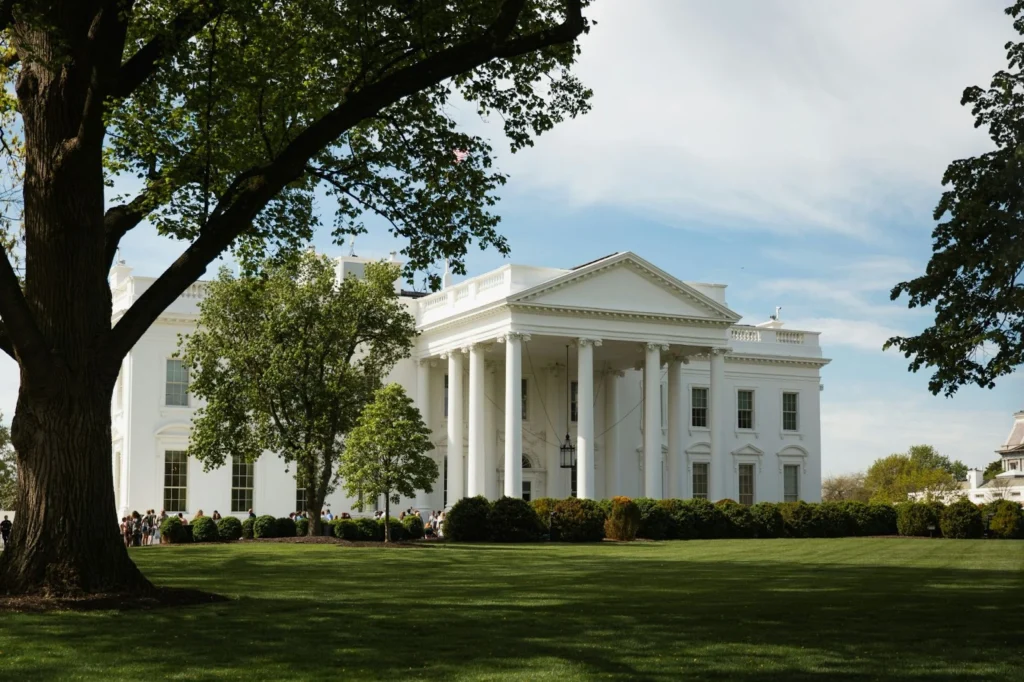Written By: Brad Campbell | March 13, 2025
The White House’s numerous windows are one of the most striking features of its architecture that, along with its signature all-white paint job, give the property its instantly-recognizable appearance.
However, since any building’s windows are its most vulnerable points, the 147 White House windows present 147 potential security vulnerabilities.
Considering that the White House was built around the turn of the 19th century, you may think that its windows are probably not up to the task of mitigating modern security threats.
But, while the White House windows still retain their classic look, there’s nothing old fashioned about their security — the windows are protected by state-of-the-art bulletproof glass and deployable security shutters.
Combined with a full range of other security measures, including high perimeter fencing, drone surveillance, infrared motion sensors, counter-sniper teams, guard dogs, secret service personnel, and more, the White House’s windows make it one of the most secure properties in the world.
For commercial property owners looking to reinforce their facilities against forced entry, active threats, and other security threats, looking at how the White House secures its windows can provide valuable insights into what your options are to achieve a similar level of security.
Needless to say, the exact specifications of the security glazing used to reinforce the White House windows remain a secret, but we can speculate based on the information available.
According to some sources, the White House windows are likely made from ballistic-grade glass-clad polycarbonate (GCP) security glazing with at least a UL 752 Level 8, or equivalent, rating. This level of GCP security glazing is designed to stop multiple shots from military-grade assault rifles and is commonly used in military applications.
Not only does this bullet-resistant security glazing protect the President and other White House occupants from ballistic attacks, but it also prevents forced entry and protects against blasts, making it an ideal all-in-one security solution for such a high level of executive protection.
Along with reinforced security framing, this incredibly robust ballistic-grade security glazing is virtually impenetrable, providing protection from active threats, terrorist attacks, riots, and more.
In 2011, several White House windows were put to the test when a man fired multiple shots at the property using a semi-automatic rifle. Although at least seven bullets purportedly impacted the White House, none of them penetrated any of its windows.
In addition to the window glazing itself, the White House windows are also equipped with security shutters that can be deployed over the windows in an emergency scenario, providing an extra layer of forced entry protection.

Although UL 752 Level 8-rated bulletproof glass is typically reserved for the most high-security applications, it’s possible to install it in a range of commercial facilities if you want to achieve the same level of bullet resistance as the White House windows.
That being said, it’s important to keep in mind that this level of ballistic-grade glazing is approximately 2.5 inches thick, making it more difficult to retrofit in certain applications, as it may require modifications to the surrounding framing and structure in order to support it.
However, there are many other types of ballistic-grade security glazing that are more practical for most commercial applications and that can provide a similar level of forced entry and active threat protection.
For example, ArmorPlast AP75 is a 3/4-inch polycarbonate and acrylic based glazing sheet that offers a UL 752 Level 1 rating, meaning it can stop multiple rounds from a 9mm ballistic attack.
Since it’s much thinner and lighter than the White House windows’ security glazing, AP75 can be retrofitted into or onto almost any existing window framing, making it a very cost-effective option for upgrading window security in commercial facilities of all types, from schools to office buildings.
This bullet-resistant security glazing has also passed the rigorous ASTM F3038 forced entry resistance test, which simulates an armed mob attempting to force entry for 15 minutes. This makes it ideal for high-security facilities, including government buildings, where protecting the property against rioters and looters is a top concern.
Despite not having as high of a ballistic resistance rating as the White House windows, AP75 is still virtually unbreakable, offering a very high level of access denial to keep active threats and other would-be intruders out of your property. Even if riddled with bullets, the glazing remains a barrier to forced entry, providing valuable time for building occupants to react and giving the authorities time to arrive and neutralize the threat.
If you require a higher level of ballistic protection, the ArmorPlast and Riot Glass ranges offer a variety of other bullet-resistant security glazing options with up to a UL 752 Level 6 rating for protecting windows against high-speed, multi-shot 9mm (Uzi) ballistic attacks.
All of our ballistic-grade security glazing sheets are made using specific formulations of polycarbonates, acrylics, and plastics, as well as laminated security glass, to achieve the perfect blend of functionality and security.
Securing your property with windows as robust as the White House’s windows is achievable with modern ballistic-grade security glazing.
While the exact glazing the White House employs is a closely guarded secret, ballistic-grade glazing solutions from ArmorPlast and Riot Glass offer highly effective, practical options for hardening commercial facilities against the same types of threats the White House faces.
Whether your main goal is to safeguard property and people against forced entry, ballistic attacks, or both, Riot Glass, LLC offers a range of customizable security glazing to meet your needs.
Contact Riot Glass today to learn more about our forced entry-resistant and ballistic-grade security solutions and schedule a consultation or threat assessment with our experts.

HOW CAN WE HELP YOU?
